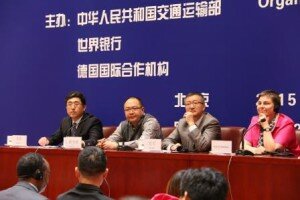 After the success of the Urban Transport Development Forum in early March, the exchange on low carbon transport between Chinese and international experts continued during a two-day conference and training in Beijing. On April 20th-21st, the Chinese Ministry of Transport, the World Bank and GIZ jointly organized the “Transport Emission Reduction Strategies and Quantification Conference and Training”.
After the success of the Urban Transport Development Forum in early March, the exchange on low carbon transport between Chinese and international experts continued during a two-day conference and training in Beijing. On April 20th-21st, the Chinese Ministry of Transport, the World Bank and GIZ jointly organized the “Transport Emission Reduction Strategies and Quantification Conference and Training”.
The two-day conference and training was split into four main sessions with different focuses:
1) Strategies of transport energy saving and emission reductions
2) Policies and measures of developing low carbon transport
3) Impact of new energy busses on energy savings and emission reductions;
4) Emission modelling and quantifications in transport sector.
In the first session, beside the presentation on development of international low carbon transport by Fang Ke from World Bank and China national scenarios of low carbon transport by Huang Quansheng from Transport Planning and Research Institute under the Chinese Ministry of Transport. Katrin Dziekan, head of transport section from the German Environmental Agency, gave a presentation on “Germany’s National Strategies to Develop Low Carbon Transport”. She stressed that the ASIF-approach (Avoid, Shift, Improve, Fuel) is the leading concept for addressing GHG emissions. In the second session, the deputy chief engineer Mr. Song Jiahua from Shenzhen Urban Transport Research Center presented the “Shenzhen Transport Energy Consumption and Emission Monitoring Platform”. He provided an in-depth review of the successful cooperation in the past two years between Shenzhen and GIZ on congestion mitigation and the development of a low-carbon transport system in Shenzhen.
On the 2nd Day, Martin Schmied from the Swiss consultancy firm INFRAS, Professor Wang Hewu from Tsinghua University and Li Bing, the director of the Research Institute of Highway under the Chinese Ministry of Transport introduced the development and evaluation of new energy buses in European and Chinese cities. Despite the national differences in market development, developing paths and eminent local challenges, the consensus was that buses with alternative fuels and drive systems can play an important role in the future in terms of increasing energy efficiency and reducing related emissions.
In the final session, Martin Schmied, Liao Kai from CUSTREC and GIZ project manager Sun Shengyang presented the China Road Transport Emission Quantification Tool. They explained the how the model was localized to the national Chinese conditions and how the tool can be applied to further cities in China.
Download the presentations here:
Day 1:
Fang Ke:International Experience in Low Carbon Transport Development
Huang Quansheng: China National Scenarios of Low Carbon Transport
Katrin Dziekan: Germany National Strategies to Develop Low Carbon Transport
Daniel Bongardt: Quantifying Transport GHG Emissions in German Cities_Daniel Bongardt
Song Jiahua: Shenzhen Transport Energy Consumption and Emission Monitoring Platform
Li Zhenyu: GEF Pilot City Transport Carbon Emission Monitoring & Evaluation
Day 2:
Martin Schmied: Evaluation of New Energy Buses in European Cities
Wang Hewu: Development Progress and Evaluation of New Energy City Bus in China
Li Bin: Electrify and Intelligent of Urban Passenger Transport
Sun Shengyang: China Road Transport Emission Model
Martin Schmied: Introduction to the China Road Transport Emission Quantification Tool
Liao Kai: Application of HBEFA


